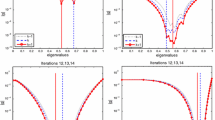Abstract
The problem of finding all the zeros of a polynomialP n (x)=x n+a n−1 x n−1+...+a 1 x+a 0, where the coefficientsa i are real, can be posed as a system ofn nonlinear equations. The structure of this system allows an efficient numerical solution using a damped Newton method; in particular it is possible to generate the triangular factors of the associated Jacobian matrix directly. This approach provides a natural generalisation of the well-known method of Durand and Kerner.
Similar content being viewed by others
References
O. Aberth,Iteration methods for finding all zeros of a polynomial simultaneously, Math. Comp. 27 (1973), 339–344.
L. Armijo,Minimization of functions having Lipschitz continuous first partial derivatives, Pacific J. Math. 16 (1966), 1–3.
L. Bairstow,The solution of algebraic equations with numerical coefficients in the case where several pairs of complex roots exist, Advisory Committee for Aeronautics, Technical Report for 1914–15, 239–252.
C. Benson,Solution of general polynomial equations, M. Sc. dissertation, University of Manchester, 1978.
Å. Björck and T. Elfving,Algorithms for confluent Vandermonde systems, Num. Math. 21 (1973), 130–137.
K. W. Brodlie,On Bairstow's method for the solution of polynomial equations, Math. Comp. 29 (1975), 816–826.
J. R. Bunch and B. N. Parlett,Direct methods for solving symmetric indefinite systems of linear equations, SIAM J. Num. Anal. 8 (1971), 639–655.
E. Durand,Solutions Numériques des Équations Algebriques, Tome I, Masson et Cie, Paris, 1960.
M. R. Farmer and G. Loizou,A class of iteration functions for improving, simultaneously, approximations to the zeros of a polynomial, BIT 15 (1975), 250–258.
R. Fletcher,Factorizing symmetric indefinite matrices, Lin. Alg. and its Applics. 14 (1976), 257–272.
T. L. Freeman,A method for computing all the zeros of a polynomial with real coefficients: A preliminary investigation, University of Manchester Numerical Analysis Report No. 23, 1977.
P. Henrici and B. O. Watkins,Finding zeros of a polynomial by the Q-D algorithm, Comm. A.C.M. 8 (1965), 570–574.
I. O. Kerner, Ein Gesamtschrittverfahren zur Berechnung der Nullstellen von Polynomen, Num. Math. 8 (1966), 290–294.
J. M. Ortega,Numerical Analysis. A Second Course, Academic Press, New York, 1972.
J. M. Ortega and W. C. Rheinboldt,Iterative Solution of Nonlinear Equations in Several Variables, Academic Press, New York, 1970.
R. F. Thomas,Corrections to numerical data on Q-D algorithm, Comm. A.C.M. 9 (1966), 322–323.
Author information
Authors and Affiliations
Rights and permissions
About this article
Cite this article
Freeman, T.L. A method for computing all the zeros of a polynomial with real coefficients. BIT 19, 321–333 (1979). https://doi.org/10.1007/BF01930986
Received:
Revised:
Issue Date:
DOI: https://doi.org/10.1007/BF01930986




